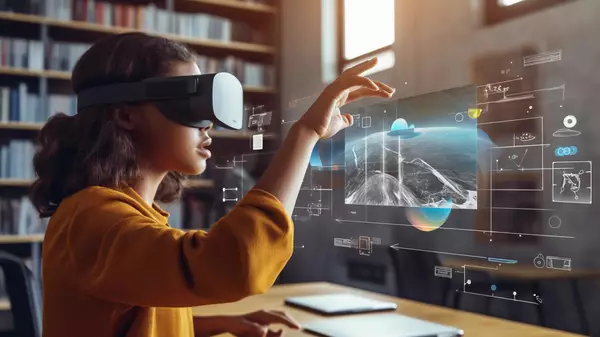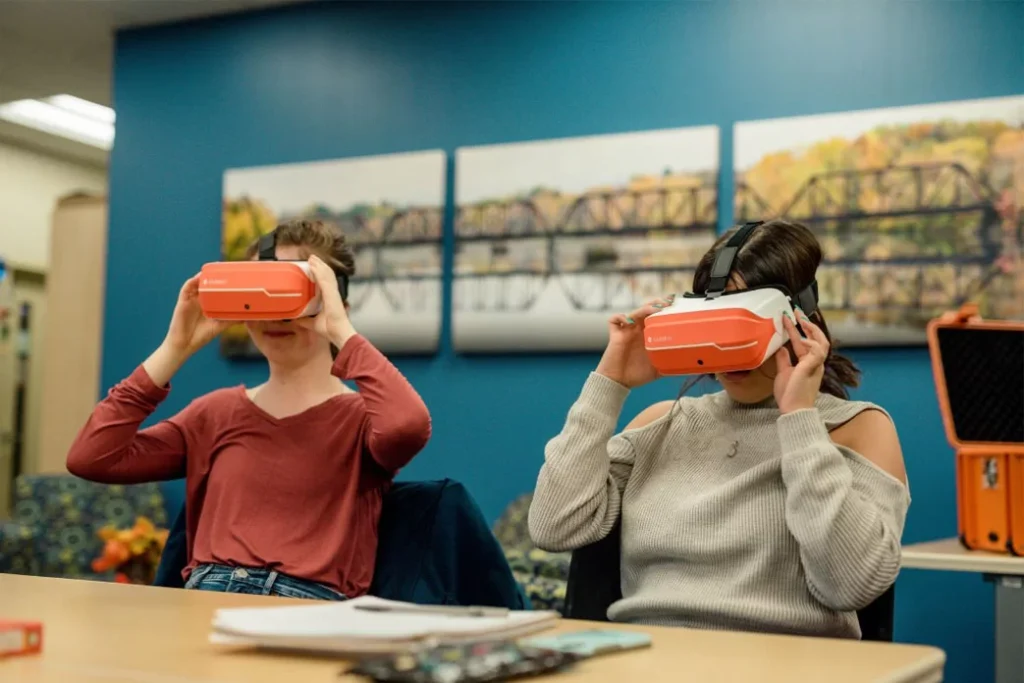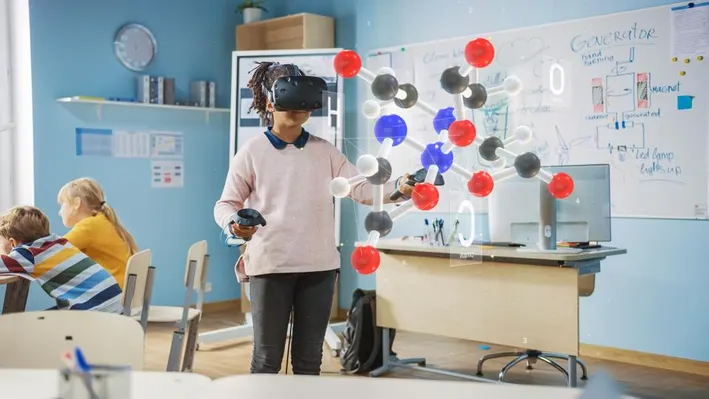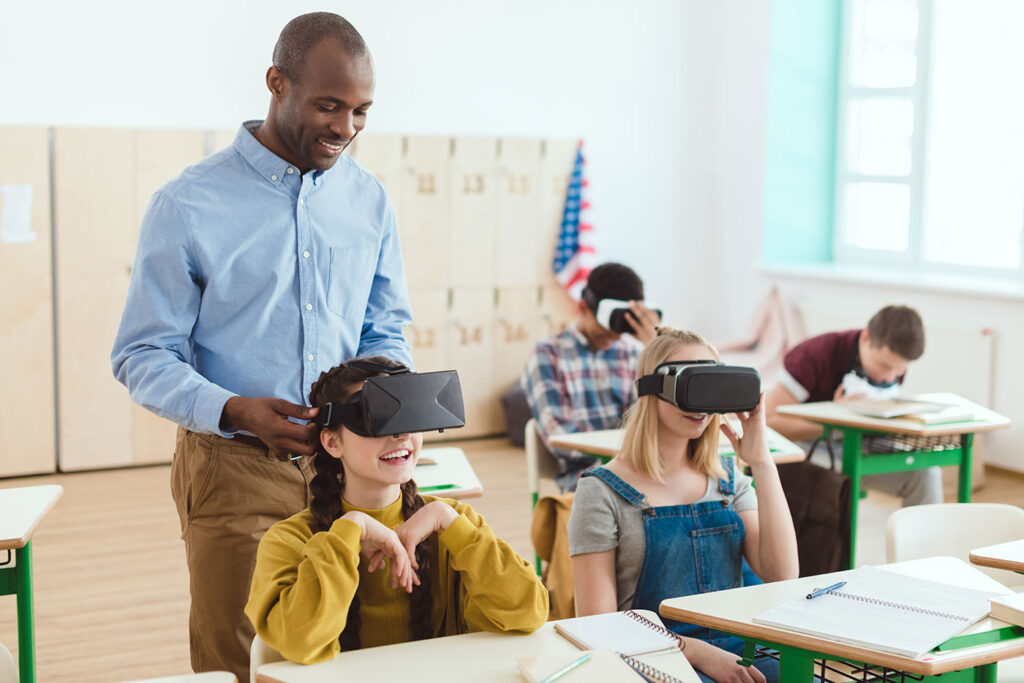
We offer a comprehensive curriculum developed by an international team, experienced teachers, and a focus on individualized and project-based learning.

We offer a comprehensive curriculum developed by an international team, experienced teachers, and a focus on individualized and project-based learning.

Imagine students stepping into a virtual Roman forum, collaborating with historical figures to resolve political debates, or virtually dissecting a human body in biology class without the need for physical specimens. Virtual Reality (VR) is no longer just a tool for gamers or tech enthusiasts—it’s reshaping education. But can it actually help students learn faster? Let’s dive into the possibilities.

retention. Why? Because VR creates multi-sensory engagement. When students see, hear, and interact within a controlled environment, they activate more neural pathways, making learning not just a mental activity but a whole-body experience.
For example, a student learning geometry can virtually build 3D shapes and manipulate them, experiencing the practical application of abstract concepts. In contrast to traditional passive learning methods, VR encourages active participation, which is key to faster comprehension.

At Future Classrooms, our approach integrates AR/VR to provide immersive educational experiences that transform the classroom. Here’s how VR tackles common educational challenges:
STEM subjects often intimidate students due to their abstract nature, especially in areas like coding and advanced mathematics. With Future Classrooms, VR modules turn abstract concepts into engaging, interactive experiences. Imagine students entering a virtual escape room where they solve coding puzzles to unlock the next level. Each challenge they conquer deepens their understanding of real-world coding applications—while keeping the experience gamified and fun.
In one module, students might program a robot to navigate a maze, giving them a hands-on understanding of algorithms, logic, and debugging without requiring costly physical robotics kits. This blend of gamification and real-world application not only makes STEM subjects approachable but ensures students grasp the material at a deeper level.
Traditional classrooms often struggle to cater to diverse learning speeds and styles. With VR, this challenge transforms into an opportunity. Future Classrooms’ adaptive platforms allow students to move at their own pace. A student struggling with fractions, for example, can practice in a virtual world where fractions are represented visually, like splitting a digital pizza into parts.
Meanwhile, advanced learners can skip ahead to tackle more complex tasks, such as solving practical problems using algebra or physics simulations. Teachers receive real-time data analytics on student performance, enabling them to provide personalized support, ensuring no one is left behind.
One of the most critical roles of education today is preparing students for the careers of tomorrow. Future Classrooms leverages VR to provide simulations and hands-on training for skills that are in high demand—without requiring physical equipment.
For example, students can explore AI and machine learning concepts by training virtual bots, dive into virtual biology labs to dissect digital specimens, or even design prototypes in a 3D modeling workshop. These immersive experiences are not only cost-effective but also spark creativity and curiosity.

While Virtual Reality holds immense promise for education, integrating it into the classroom isn’t without its challenges. However, each challenge also presents an opportunity to innovate, and Future Classrooms is paving the way with solutions that empower schools to embrace VR seamlessly.
The cost of VR hardware, software, and necessary upgrades to existing school infrastructure can be a significant barrier, especially for institutions with tight budgets. However, Future Classrooms has designed a cloud-based platform that removes the need for high-end, expensive equipment. Schools can use affordable VR headsets and rely on our platform’s scalable, lightweight infrastructure, ensuring that the benefits of VR reach every classroom regardless of budget size.
Additionally, we partner with schools to offer tailored implementation plans. These plans help allocate resources efficiently, making the adoption of VR more feasible for institutions of all sizes.
For many teachers, VR technology represents uncharted territory. Without proper training, even the best tools can go underutilized. This is why Future Classrooms developed the Teacher Transformation Program, a comprehensive professional development initiative.
Another significant challenge is ensuring that VR content is equally accessible across urban and rural schools. Internet connectivity issues, device compatibility, and variability in classroom setups can hinder widespread adoption. Future Classrooms addresses these challenges through:
While these challenges might seem daunting, they represent the growing pains of any paradigm shift. Future Classrooms leverages these hurdles as opportunities to create solutions that are accessible, scalable, and impactful.
Through strategic innovation, comprehensive teacher support, and adaptable technology, Future Classrooms is redefining how schools view and implement VR. The result? A new era of immersive, equitable, and future-proof education.
Understanding how Virtual Reality impacts the brain can offer deeper insights into why it’s such a transformative tool for education. This section could add significant value by highlighting the scientific basis of VR’s effectiveness, appealing to educators, administrators, and parents who prioritize evidence-based approaches.
Emerging research suggests that extended use of VR in education could enhance spatial reasoning, improve multitasking skills, and even increase empathy through role-playing scenarios. For example, students can virtually experience life in a different cultural context, fostering a deeper understanding of global issues.
Virtual Reality creates immersive, multi-sensory experiences that engage students actively in the learning process. By combining visual, auditory, and interactive elements, VR helps students understand complex concepts faster, retain information longer, and stay motivated.
Yes, VR caters to diverse learning styles. Visual learners benefit from detailed simulations, kinesthetic learners enjoy hands-on interactions, and auditory learners can follow engaging soundscapes. Additionally, VR’s adaptive learning pathways allow students to progress at their own pace, ensuring personalized education for all.
While VR excels in STEM subjects like coding, robotics, and biology, its applications extend across disciplines. Students can explore historical sites in history, visualize literary settings in language arts, and practice real-world scenarios in vocational training. The versatility of VR makes it a powerful tool for a wide range of subjects.
Key challenges include budget constraints, lack of training for educators, and infrastructure limitations. Future Classrooms addresses these by offering cost-effective, cloud-based solutions, comprehensive teacher training programs, and flexible hardware integration to ensure VR is accessible for all schools.
Not necessarily. With platforms like Future Classrooms, schools can use affordable VR headsets and cloud-based resources, reducing the need for extensive infrastructure changes. Offline compatibility and hardware flexibility further simplify implementation.
Teachers receive support through programs like Future Classrooms’ Teacher Transformation Program. This initiative includes pre-platform training, ongoing webinars, ready-to-use lesson plans, and access to a collaborative online community for continuous professional development.
Absolutely. Future Classrooms offers offline-compatible modules and hardware options tailored to different budgets. Localized, culturally relevant content ensures that students in all environments can benefit from immersive VR learning experiences.
VR provides hands-on experiences in future-ready fields like AI, robotics, and app development. By simulating real-world environments and challenges, students gain practical skills that align with industry demands, fostering creativity, problem-solving, and technological fluency.
No, VR complements traditional methods by enhancing engagement and understanding. Teachers continue to guide and mentor students, using VR as a tool to enrich lessons and provide deeper insights into topics.
Schools can begin by exploring solutions like Future Classrooms, which offer step-by-step onboarding, teacher training, and tailored implementation plans. By starting small and scaling gradually, schools can integrate VR effectively without overwhelming staff or budgets.
Have more questions? Reach out to Future Classrooms to learn how VR can transform your school and create a future-ready education environment. Let’s make learning immersive, engaging, and impactful!

Virtual Reality is not just a flashy trend; it’s a powerful tool that redefines how we approach learning. By immersing students in interactive environments, VR speeds up comprehension, enhances engagement, and ensures lasting retention of knowledge.
Are you ready to embrace VR in your school? Explore how Future Classrooms can help you create immersive learning experiences that empower both students and teachers. Get in touch with us to learn more or schedule a demo today!
Let’s shape the future of education together.

FutureClassroom is Southeast Asia's largest coding platform for K-12, empowering students with essential skills in Web Development, Game Development, Python, and AI. Aligned with Cambridge and Pearson standards, our platform combines interactive learning and real-world projects to prepare young learners for a future driven by technology.
View all posts
FutureClassroom is Southeast Asia's largest coding platform for K-12, empowering students with essential skills in Web Development, Game Development, Python, and AI. Aligned with Cambridge and Pearson standards, our platform combines interactive learning and real-world projects to prepare young learners for a future driven by technology.
Get all the latest information, support and guidance about the cost of living with kindergarten.
Start Registration